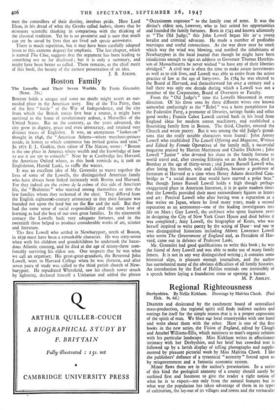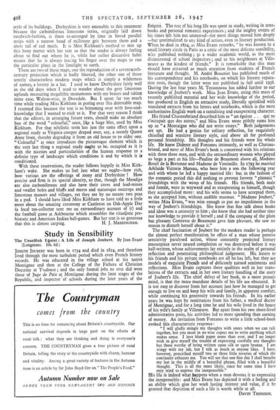Regional Righteousness
DRAINED and desiccated by the catchment board of centralised mass-production, the regional spirit still finds indirect outlets and oozings for itself for the simple reason that it is a proper expression of the spirit of man. We blast our local countrysides with one hand and write about them with the other. Here is one of the first books in the new series, the Vision of England, edited by Clough and Amabel Williams-Ellis, which ministers to man's organic relation with his particular landscape. Miss Kirkham writes in affectionate intimacy with her Derbyshire, and her brief but crowded text is followed up by a lavish display of telling photographs and supple- mented by pleasant pictorial work by Miss Malvina Cheek. I like the publishers' defiance of a tyrannical " austerity " forced upon us by misgovernment and a fantastic economic system. Minor flaws there are in the author's presentation. In a series of this kind the geological anatomy of a county should surely be outlined first and foremost to give the reader a right notion of what he is to expect—not only from the natural features . but in what way the population has taken advantage of them in its types of cultivation, the lay-out of its villages and towns and the vernacular
style of its buildings. Derbyshire is very amenable to this treatment because the carboniferous limestone series, originally laid down sandwich-fashion, is there re-arranged by time in broad parallel strips with a narrow band of millstone grit between them and a short tail of red mans. It is Miss Kirkham's method to mix up this bony matter with her text so that the reader is always feeling about to find out where he is, while her rather discursive habit means that he is always tracing his finger over the maps to run the particular place in the limelight to earth.
There are two of these maps, one the reproduction of a seventesmth- century projection which is badly blurred, the other one of those utterly characterless modern maps which is simply a wilderness of names, a lottery in a hat. I used to know Derbyshire fairly well in the old days when I used to wander about the grey limestone uplands measuring megalithic monuments with my braces and taking mine ease, Walton-wise, in Dovedale. But I spent far too much time while reading Miss Kirkham in poring over this detestable map. I resented this because the text is so brimming over with love-and- knowledge that I wanted to stick to it. For that very reason I think that the editors, in arranging future texts, should make an absolute ban of the word "colourful," once, like a huge blot, used by Miss Kirkham. For that nihilistic term has just the same effect upon a regional study as Virginia creeper draped over, say, a seemly Queen Anne front, thereby degrading it from an old house to ye older one. " Colourful " at once introduces the picturesque element which is the very last thing a regional study ought to be, occupied as it is with the niceties and particularities of the human response to a definite type of landscape which conditions it and by which it is conditioned.
With these reservations, the reader follows happily in Miss Kirk- ham's wake. She makes us feel just what we ought—how rich, how various are the offerings of stony and Derbyshire ! How precise and firm is its special identity, so that, though the Mendips are also carboniferous and also have their caves and lead-mines and swallet holes and bluffs and meres and statuesque outcrops and limestone manors and villages, yet they are by no means two peas in a pod. I should have liked Miss Kirkham to have told us a little more about the amazing ceremony at Castleton on Oak-Apple Day Ca local tax-collector sent me an extraordinary account of it) and the football game at Ashbourne which resembles the ritualistic pre- historic and American Indian ball-games. But her text is so generous



































 Previous page
Previous page